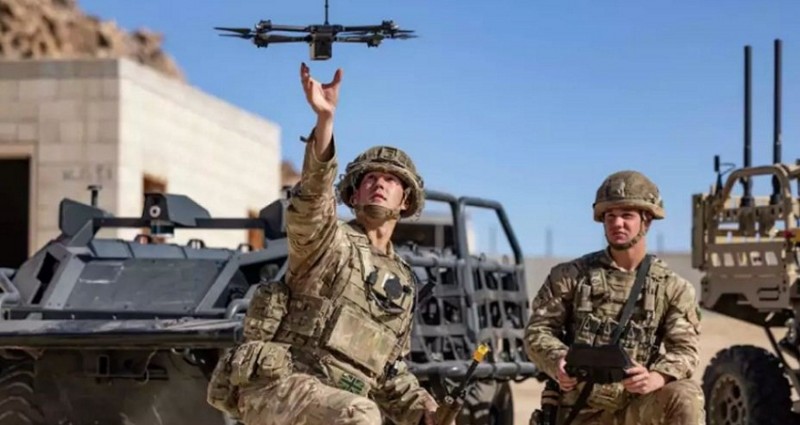
Amid escalating tensions, military strategists in the United States and China are preparing for a new form of warfare using fleets of drones with artificial intelligence (AI) capabilities. These drones, both airborne and naval, are envisioned to operate collectively, akin to a swarm of bees, to overpower adversaries.
In this envisioned scenario, hundreds or even thousands of drones could engage in synchronized combat under the control of a single operator. Some drones would serve as scouts, while others would launch attacks. These drones could adapt their strategies mid-mission based on pre-programmed instructions rather than direct commands.
The race for drone swarm technology between the world's leading AI powers, reminiscent of the Cold War arms race, poses significant challenges. Unlike nuclear weapons, which were relatively easier to control, drones driven by software could potentially be acquired by rogue states or militant groups.
The Pentagon is hastening the development of low-cost, disposable drones as a deterrent against China's assertiveness, particularly concerning Taiwan. Both Washington and Beijing see AI-enabled weapons as inevitable, with each side justifying its pursuit by citing the actions of the other.
However, the unchecked proliferation of drone swarm technology raises concerns about increased global instability and conflict, according to Margarita Konaev, an analyst at Georgetown University.
While the United Nations has long sought to limit the spread of drone technology, efforts have faced challenges. Recent military contracts and developments indicate the prioritization of AI-related systems by both the US and Chinese militaries.
The Pentagon's recent call for bids for small unmanned maritime interceptors highlights the ambitious goals, including operating in GPS-denied environments and executing complex autonomous behaviors.
Although it remains unclear how many drones a single operator could manage, advancements in drone swarm coordination are rapidly progressing. Companies like Auterion are developing software to enable operators to control multiple drones simultaneously, with expectations of controlling hundreds within a year.
China, too, boasts advancements in drone technology, with reports of drones self-adapting to overcome communication disruptions and completing missions autonomously.
The competition for drone swarm supremacy has raised concerns about its implications for global stability. Efforts to mitigate risks, such as discussions on AI safety between the US and China, have taken a backseat amid the race for autonomous drones.
While military analysts anticipate it will take several years for fully capable drone swarms to be deployed, developments in Ukraine highlight the strategic importance of drone technology in modern warfare.
Despite challenges such as electronic interference and coordination over vast areas, research continues on developing swarming tactics for various combat scenarios.
Projects like DARPA's Autonomous Multi-Domain Adaptive Swarms-of-Swarms and OFFensive Swarm-Enabled Tactics aim to explore the potential of autonomous drones in warfare, with implications for future conflicts.
As the race for drone swarms accelerates, the implications for global security and stability remain uncertain, with experts warning against the risks of unchecked proliferation and escalating tensions between major powers.
Former U.S. Secretary of State Henry Kissinger, before his passing, urged cooperation between Beijing and Washington to prevent the unchecked proliferation of AI arms. However, efforts to address AI safety have been overshadowed by the race for drone swarms.
Analysts warn that the competition between the US and China could exacerbate global instability, with each side likely to accelerate its efforts in response to the other's advancements.
There are concerns that China could share swarm technology with adversarial nations or repressive regimes, potentially amplifying security threats worldwide. Additionally, other countries, including Russia, Israel, Iran, and Turkey, are also developing similar technology, further complicating the landscape.
While discussions between the US and China on AI safety are anticipated, it remains unclear whether military applications of drone swarms will be on the agenda.
Despite projections that it may take several years for combat-ready drone swarms to materialize, recent developments suggest breakthroughs could occur sooner than expected.
Both the US and China possess unique strengths in hardware and software development, with experts debating which country holds the advantage. However, the effectiveness of drone swarms in actual combat scenarios remains a subject of contention.
As attention shifts to conflicts like the war in Ukraine, where drones play a pivotal role, the strategic significance of drone technology becomes increasingly evident. Challenges such as electronic interference and coordination over vast territories underscore the complexities of deploying drone swarms in real-world situations.
Projects like DARPA's initiatives aim to explore the potential of autonomous drones in warfare, with implications for future conflicts. However, concerns persist regarding the ethical and security implications of autonomous weapons systems, particularly in the absence of international regulations.
While advancements in drone technology offer new possibilities for military operations, they also raise profound questions about the nature of warfare and the potential for unintended consequences. As the race for drone swarms intensifies, the need for international cooperation and dialogue on AI safety becomes increasingly urgent.
How Russian Drone Attack Damages Energy Facilities in Southern Ukraine
Ukraine Successfully Thwarts Russian Drone Attack, Destroys 20 Drones Overnight
Taiwan war games to simulate repelling a Chinese drill that turns into attack